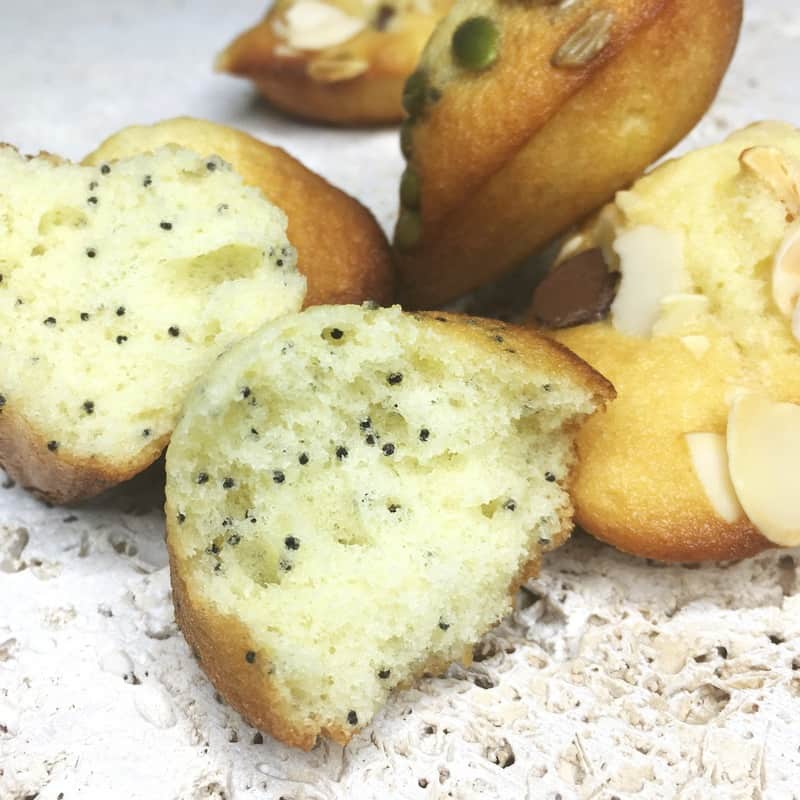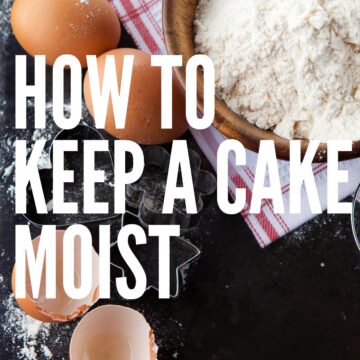This post is a part of my Madeleine series in tribute to this iconic French pastry and all that it means - from madeleine definition, choosing the right pan, all the secrets of authentic madeleine hump, and storage suggestions - you name it!
What is the history of madeleines? Where did they originate from? Let's discover the mysterious story that brought the most iconic French dessert. It can be found in many bakeries and patissiers across France and abroad.

French madeleines, small sponge cakes with distinct shell-like shapes, have an exciting history.
They undoubtedly originate from France, but the historical details remain quite mystical. Several myths exist in regard to the madeleine creation.
Jump to:
Origin of madeleines
One legend goes back perhaps to the Middle Ages and is centered on the girl named Madeleine.
It says that during her pilgrimage to Santiago de Compostella in Spain, she was given these little cake-like cookies baked in shells. She brought the recipe back with her to France.
But there is another story - the story of Commercy, the capital of madeleine.
Petites madeleines were invented in the kitchen of Stanisław Leszczyński (or another spelling Stanislas Leczinski), the deposed king of Poland when he was exiled to Lorraine.
The dessert was created by one of his maids. Many food historians believe that the cook was a young servant girl named Madeleine Paulmier.
In 1755, Stanislas, King of Lorraine, received. But, during the meal, he is told that his pastry chef, angry following a quarrel, has returned his apron.
A meal without dessert cannot be conceived. The butler makes a point of saving the king from this dishonor, provided he is given a little time.
While society amuses itself with games, stories, entertains the dwarf Ferry who pulls out a giant pie, we are busy in the pantry.
And here is the dessert. We bring to the guests cakes of an original shape, golden, and fondant… A marvel!Delighted, the king summons the author of this miracle: he is presented with a young and pretty servant, pink with confusion and her hands still white with flour...
– “What is the name of this masterpiece? – “
Madeleine de Commercy
He has no name, sire; that's what we do at my house, in Commercy, on holidays. – “
And what is your name?” – “
Madeleine”
– “Well, he will be called like you: Madeleine de Commercy."
The story says that in 1755 King Louis XV first tasted madeleines at the Chateau Commercy on his visit to the Lorraine region.
The wife of Louis and daughter of Stanislas, Maria Leszczyńska, started serving madeleines to the French court in Versailles. So she created an appetite for madeleines that spread throughout France.
It is no wonder since people love these small cakes with their delicate taste - it was just about perfect!
When Stanislas died, one of his pastry chefs, Pantaléon Colombé, moved to Commercy.
He taught the secrets for making madeleines which would pass through time with the restaurant owner descendants.
Amongst the craftsmen, the Colombé family has gained over a long time, in all fairness, a good reputation... Until 1817, the madeleine didn’t make much progress. A pastry cook, competing with his rival cooks decided to lower the price and to give the recipe to all and sundry in order to out-sell them. His sparring partners could only save face by lowering their price by half and by improving the cake’s quality. If the people had benefited from this “price war”, the fighters have made an even larger profit. Nowadays, they are making even more in dozens than in the single units before.
Charles Dumont
Interestingly the Colombé family still manages a few madeleine production techniques and recipes, such as Cloche d’Argent and Cloche Lorraine.
Yet another story dated to the 19th century gives credit to madeleine's creation to Jean Avice, a "master of choux pastry," who worked as a chef for Prince Talleyrand.
He baked cakes in aspic molds and probably invented the recipe.
The first madeleine recipe
The first recipe's appearance goes back to 1758, the middle of the 18th century.
People used metal molds to bake "cakes à la Magdeleine and other small desserts" during the 18th century.
However, the first recipe was mentioned by culinary writers only in the 19th century.
And large-scale production of madeleines began in the 1760s when Commercy became an important manufacturing center for these treats.
The number of the ‘madeleiniers’ (madeleine makers) expanded significantly. Twenty thousand madeleine cakes would be created every day during the early 1840s.
In 1870, when Bismarck penetrated Commercy with the Chancellor and Prussian army, his secretary wrote in his diary:
Signboards were found at the doors of many houses with the inscription: ‘fabrique de madeleines’ (madeleine making place). With their melon-shape, the biscuits were a great success in France. We made sure we sent some boxes back to the homeland.
Madeleine making
In 1852, the future Emperor of France and aspiring autocratic leader Louis-Napoleon inaugurated the Paris-Strasbourg railway line with the stop at Commercy. There, his escort discovered madeleines.
By the late 1800s, the train led to even greater access to this delicious treat.
This train facilitated a young lady from Commercy Anne Marie Caussin to move to Paris. She married the Marquis de Carcano, the heartthrob of the Parisian jet-set.
His wife, Madame de Cassin, settled a salon in her mansion where she served fresh madeleines brought to her every day by the last train from Commercy.
Reaching Paris, these sweet treats became a great staple of the bourgeoisie French population.
On the 13th October 1874, a local decree approved the sale of madeleines at the Gare de Commercy, a stop on the Paris-Strasbourg railway line.
Women loaded their large wicker baskets with madeleines and shouted to honor their baked goods to attract customers. It was a very unique show, typical of Commercy station at that time.
When people traveled through Commercy, you couldn't help but feel that something historic had happened.
The vendors selling madeleines were there since 1874 and until the eve of the Second World War.
The daily production of madeleines reached 2.500 madeleines, approximately 60 kilograms predominantly sold on the stations’ platforms.
In the middle of the 20th century, madeleines became famous thanks to French writer Marcel Proust and his autobiographical novel "In Search of Lost Time" ("À la recherche du temps perdu" in French).
In his first volume, Swann's Way (Du Côté de chez Swann in French), Proust wrote that the smell and taste of a madeleine unconsciously brought memories from his childhood.
There is a theory that everyone has their own madeleine memory when some smell or taste evokes the memory of the past to come to life again.
Modern madeleines
Over time, the weight of a madeleine (la madeleine in French) has been reduced from 90 -100 g to 30 g before the Second World War and 25 g nowadays.
But the madeleine ingredients reminded unchanged: flour, butter, sugar, eggs, baking powder, and lemon zest or vanilla extract.
Today, two factories continue the traditional production of real madeleines of Commercy.
One is a family bakery Saint Michel - Grojean founded in 1905. Another one has been operated by the Zins family since 1951 and is called Boite à Madeleine.
The madeleine recipes continue to develop.
Today, our pastry chefs continue to uphold our traditional know-how, and pass it on day-by-day to the younger generations.
St Michel, n°1 of the Madeleine in France, according Nielsen distributor panels YTD P07 2019
Madeleines, a bakery staple in France and across Europe for centuries, have proudly represented their country on 2006's Europe Day.
These days, madeleines are not just about the taste. The appearance has become an essential factor in addition to how well these tea cakes are received by consumers who want their treat customized for any occasion.
The culinary world full of talented chefs creates new recipes to elevate a humble madeleine to the world’s finest French food served at high-end restaurants.
Madeleine recipes
Do you need to travel to France to get your craving fixed? Not really.
You can find madeleines at almost every French cafe, French market, Starbucks, many café shops, supermarkets, and even wholesale warehouses worldwide.
The French usually serve madeleines with a cup of tea or coffee in the morning.
Also, the French children enjoy cakes at four in the afternoon for the goûter, which is the French equivalent of the British afternoon tea.
The internet is full of traditional recipes for madeleines created by chefs and blogger-amateurs.
When it comes to making the authentic French madeleines with a hump on top seems like an impossible task for many.
But if you try this foolproof madeleine recipe, there is no doubt that you will succeed. It works every time and guarantees success!
The classic recipe requires basic ingredients (unsalted butter, large eggs at room temperature, sugar, flour, lemon rind), a madeleine pan, and a little bit of patience and precision.
And once you enjoy warm madeleines, possibly with your afternoon tea, you might remember the fascinating history behind these little French tea cakes.
More, if you ever want to make twists on classic madeleines, try these recipes next!











Gina-Dianne Harding says
The legend I heard is they were named in honor of St Mary Magdalene, who arrived on the shores of Provence in a boat without oars after she was banished from the holy land. The shape of the Madeline's is like a little boat.
Irina says
Hello Gina-Dianne, I've read a few versions of the madeleine origin. So maybe the legend you heard about took place... Thanks for your comment and for stopping by!!